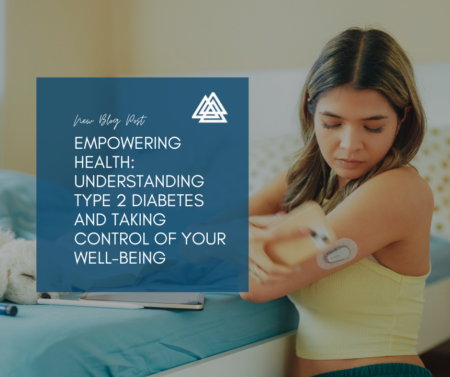 Diabetes is a chronic condition that affects millions of people worldwide, with Type 2 diabetes being the most prevalent form. Understanding this condition and taking proactive steps to manage it can significantly improve your health and quality of life. This blog post aims to provide an overview of Type 2 diabetes, its causes, symptoms, treatment options, and lifestyle changes that can empower you to take control of your well-being.
Diabetes is a chronic condition that affects millions of people worldwide, with Type 2 diabetes being the most prevalent form. Understanding this condition and taking proactive steps to manage it can significantly improve your health and quality of life. This blog post aims to provide an overview of Type 2 diabetes, its causes, symptoms, treatment options, and lifestyle changes that can empower you to take control of your well-being.
What is Type 2 Diabetes?
Type 2 diabetes is a metabolic disorder characterized by high blood sugar levels (hyperglycemia). It occurs when the body becomes resistant to insulin or does not produce enough insulin to regulate blood sugar effectively. Insulin is a hormone produced by the pancreas that helps glucose (sugar) from food enter the cells to be used for energy.
Causes and Risk Factors
Several factors contribute to the development of Type 2 diabetes:
- Insulin Resistance: Cells become resistant to insulin, leading to elevated blood sugar levels.
- Genetics: Family history of diabetes increases the risk.
- Lifestyle Factors: Lack of physical activity, poor diet (high in refined sugars and unhealthy fats), and excess weight, especially around the abdomen (central obesity).
- Age and Ethnicity: Risk increases with age, and certain ethnic groups (such as African Americans, Hispanics, Native Americans, and Asians) are more prone to developing diabetes.
Symptoms of Type 2 Diabetes
Type 2 diabetes symptoms may develop gradually and can include:
- Increased Thirst: Feeling constantly thirsty and needing to drink more fluids.
- Frequent Urination: Needing to urinate more often, especially at night.
- Fatigue: Feeling tired and lacking energy, even with adequate rest.
- Blurry Vision: Vision may become blurry due to changes in fluid levels in the eyes.
- Slow Healing: Wounds and cuts may heal slowly.
- Weight Loss (Unintentional): Despite eating more (polyphagia), some people may lose weight.
It’s essential to recognize these symptoms and seek medical advice for proper diagnosis and treatment.
Diagnosing Type 2 Diabetes
Diagnosis typically involves blood tests to measure blood sugar levels. These tests include:
- Fasting Plasma Glucose Test: Measures blood sugar after fasting for at least eight hours.
- A1C Test (Glycated Hemoglobin): Reflects average blood sugar levels over the past 2-3 months.
- Oral Glucose Tolerance Test (OGTT): Measures blood sugar levels before and after drinking a sugary beverage.
Managing Type 2 Diabetes
Medical Treatment
Treatment aims to keep blood sugar levels within a target range to prevent complications:
- Medications: Oral medications (e.g., metformin, sulfonylureas) and insulin therapy may be prescribed to control blood sugar levels.
- Monitoring: Regular blood sugar monitoring helps track how well treatment is working.
Lifestyle Changes
Healthy lifestyle habits play a crucial role in managing Type 2 diabetes:
- Diet: Eat a balanced diet rich in fruits, vegetables, whole grains, lean proteins, and healthy fats. Limit sugar, refined carbohydrates, and saturated fats.
- Exercise: Engage in regular physical activity, such as brisk walking, swimming, or cycling, for at least 150 minutes per week.
- Weight Management: Achieve and maintain a healthy weight to improve insulin sensitivity.
- Stress Management: Practice relaxation techniques like yoga, meditation, or deep breathing to reduce stress levels, which can affect blood sugar levels.
- Quit Smoking: Smoking increases the risk of diabetes complications. Quitting smoking improves overall health.
Monitoring and Self-Care
- Blood Sugar Monitoring: Regularly check blood sugar levels as recommended by your healthcare provider.
- Foot Care: Check feet daily for cuts, blisters, or sores, and seek prompt medical attention for any foot problems.
- Annual Checkups: Schedule regular checkups with healthcare providers to monitor diabetes management and screen for complications.
Empowering Yourself
Education and Support
- Diabetes Education: Learn about diabetes management through classes, support groups, or online resources.
- Self-Care: Take an active role in managing your diabetes by understanding medications, monitoring blood sugar levels, and making informed lifestyle choices.
- Support Network: Connect with others living with diabetes for encouragement, advice, and shared experiences.
Setting Goals
- Personalized Plan: Work with healthcare providers to create a diabetes management plan tailored to your needs and goals.
- Achievable Steps: Break goals into smaller, achievable steps to maintain motivation and track progress.
Conclusion
Type 2 diabetes requires lifelong management, but with proper education, lifestyle changes, and support, you can take control of your health and well-being. By understanding the condition, recognizing symptoms, adhering to treatment plans, and adopting healthy habits, you can effectively manage blood sugar levels and reduce the risk of complications. Remember, you are not alone—seek support from healthcare providers, family, and peers to navigate the journey towards a healthier, empowered life with Type 2 diabetes.
